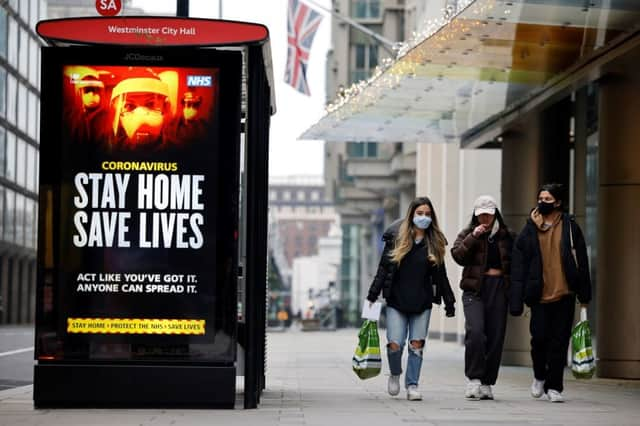Only 5 UK areas saw a rise in Covid cases at the end of January - how regions compare


Only five local areas in the UK have recorded a week-on-week increase in Covid-19 case rates, new figures show.
All national and regional rates are now back at levels seen before the new year, with rates only rising in a small number of local authority areas.
Advertisement
Hide AdAdvertisement
Hide AdDerbyshire Dales and East Lindsey in the East Midlands, along with Argyll and Bute, East Renfrewshire and Midlothian in Scotland, are the only local authority areas in the country to record an increase in rates for the seven days to 27 January.
However, in all five localities the week-on-week rise was small.
The falling rates in the vast majority of the UK suggests the lockdowns that are currently in place across all four UK nations are having an effect in driving down the number of new reported cases of coronavirus.
Here is how each nation and region compare.
England
The rate of new cases in England as a whole in the week to 27 January stood at 293.9, which is down from 422.4 in the previous week, and the lowest rate since the week to 16 December.
London
Advertisement
Hide AdAdvertisement
Hide AdThe capital still has the highest rate for any region in England, with the seven-day rate of new cases currently at 354.7 per 100,000 people, down from 560.3 one week earlier.
However all London boroughs are recording a fall in rates, with the largest seen in Hounslow, down from 787.4 to 475.8, Barking and Dagenham, down from 739.8 to 453.4, and Greenwich, down from 628.6 to 343.1.
South East England
The regional rate for South East England is currently at its lowest since 13 December, with 279.9 cases per 100,000 people in the seven days 27 January, down from 412.1 a week earlier.
Rushmoor has seen the biggest drop, falling from 745/3 to 416.5, followed by Eastbourne, down from 727.7 to 400.0, and Slough, down from 869.3 to 589.8.
South West England
Advertisement
Hide AdAdvertisement
Hide AdThe South West currently has the lowest regional rate in England at 199.5, which is down week-on-week from 283.7, the lowest since 26 December.Local rates are falling in every area, with the largest drops recorded in Bournemouth, Christchurch and Pool, down from 659.7 to 453.0, Plymouth, down from 292.3 to 138.9, and Mendip, down from 295.0 to 179.1.
Eastern England
The regional rate for Eastern England currently stands at 305.1, which is down week-on-week from 439.7 and marks the lowest level since 14 December.
The biggest falls have been seen in Tendring, down from 700.7 to 415.5, Harlow, down from 5858 to 405.4, and Castle Point, down from 579.8 to 338.6.
East Midlands
The East Midlands is the only region in England to house areas where case rates have shown a week-on-week rise.
Advertisement
Hide AdAdvertisement
Hide AdHowever, this only applies to the Derbyshire Dales, where the rate is up from 206.0 to 243.3, and East Lindsey, where rates have increased slightly from 113.6 to 122.8. All other areas have shown a week-on-week drop.
West Midlands
The rate for the whole of the West Midlands currently stands at 350.4 cases per 100,000 people, which is the second highest overall in England.
Although the week-on-week rate is down from 528.5 and all local areas are seeing a fall, with the largest recorded in Wolverhampton, which is down from 790.2 to 484.1.
North West England
Rates have fallen in all areas in the North West and currently stands at 320.1, down week-on-week from 442.1.
Advertisement
Hide AdAdvertisement
Hide AdThe areas recording the biggest seven-day falls are Carlisle, down from 667.1 to 376.3, Wirral, down from 599.1 to 335.8, and Knowsley, down from 920.7 to 658.2.
North East England
The regional rate in the North East is currently 252.6, down week-on-week from 318.5 and the lowest since 27 December.
The biggest drops have been seen in Redcar and Cleveland, down from 420.0 to 304.0, Gateshead, down from 270.2 to 186.1, and Sunderland, down from 380.3 to 297.1.
Yorkshire and the Humber
Yorkshire and the Humber has the second lowest rate in England overall at 211.3 cases per 100,000 people, down week-on-week from 243.3 and the lowest since 28 December.
Advertisement
Hide AdAdvertisement
Hide AdCases are down in all local areas, with York seeing the largest fall from 331.4 to 205.1, followed by Ryedale, down from 222.1 to 99.3, and Hambleton, down from 281.7 to 176.9.
Scotland
Scotland recorded 144.3 cases per 100,000 people in the seven days to 27 January, which is down week-on-week from 191.0, and the lowest rate since 26 December.
Three areas recorded a slight rise in cases, with Argyll and Bute rising from 64.1 to 69.9, East Renfrewshire up from 166.4 to 171.7, and Midlothian up from 117.9 to 119.0.
All other areas in Scotland saw a fall, with the biggest drop recorded in Comhairle nan Eilean Siar (Western Isles), which is down from 164.7 to 44.9.
Wales
Advertisement
Hide AdAdvertisement
Hide AdIn the seven days to 27 January, Wales recorded 152.8 coronavirus cases per 100,000 people, marking the lowest seven-day rate since 7 October.
This figure is also well below the second-wave peak of 649.12 on 17 December.
Rates are down in all local areas of Wales, with the biggest drops in Wrexham, which is down from 552.4 to 385.4, Flintshire, down from 413.8 to 262.0, and Newport, down from 300.6 to 155.8.
Northern Ireland
The rate in Northern Ireland stood at 226.7 cases per 100,000 in the seven days to 27 January, which is down from 302.0 in the previous week, and the lowest rate since 25 December.
All areas of Northern Ireland continue to record a drop in rates, with the biggest fall in Armagh City, Banbridge and Craigavon, which has fallen from 547.6 to 406.6.